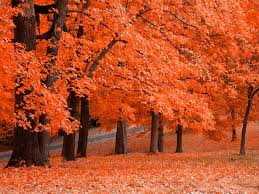WHY AUTUMN LEAVES TURN RED?
 We all enjoy the colors of autumn leaves. Leaves are nature's food factories. Plants take water from the ground through
their roots. They take in carbon dioxide
from the air. Sunlight is use to turn
water and carbon dioxide into oxygen and glucose. The way plants turn water and carbon dioxide
into oxygen and sugar is called photosynthesis.
A chemical called chlorophyll helps make photosynthesis happen. Chlorophyll is what gives plants their green
color.
We all enjoy the colors of autumn leaves. Leaves are nature's food factories. Plants take water from the ground through
their roots. They take in carbon dioxide
from the air. Sunlight is use to turn
water and carbon dioxide into oxygen and glucose. The way plants turn water and carbon dioxide
into oxygen and sugar is called photosynthesis.
A chemical called chlorophyll helps make photosynthesis happen. Chlorophyll is what gives plants their green
color.
 During winter, there is not enough light or water for
photosynthesis. The trees will rest, and
live off the food they stored during the summer. The green chlorophyll soon disappears from
the leaves. In some trees, like maples, the
glucose is trapped in the leaves after photosynthesis stops. Sunlight and the cool nights of autumn cause
the leaves turn this glucose into a red color. The brown color of trees like oaks is made
from wastes left in the leaves.
During winter, there is not enough light or water for
photosynthesis. The trees will rest, and
live off the food they stored during the summer. The green chlorophyll soon disappears from
the leaves. In some trees, like maples, the
glucose is trapped in the leaves after photosynthesis stops. Sunlight and the cool nights of autumn cause
the leaves turn this glucose into a red color. The brown color of trees like oaks is made
from wastes left in the leaves.
 Autumn leaves turn fiery-red in an attempt to store up as
much goodness as possible from leaves and soil before a tree settles down for
the winter. The worse the quality of
soil, the more effort a tree will put in to recovering nutrients from its leaves
and the redder they get. In the
floodplain, where the soil was packed full of goodness, the autumn leaves remained
yellow.
Autumn leaves turn fiery-red in an attempt to store up as
much goodness as possible from leaves and soil before a tree settles down for
the winter. The worse the quality of
soil, the more effort a tree will put in to recovering nutrients from its leaves
and the redder they get. In the
floodplain, where the soil was packed full of goodness, the autumn leaves remained
yellow.
 It is the combination of all these things that make the
beautiful fall foliage colors we enjoy each year.
It is the combination of all these things that make the
beautiful fall foliage colors we enjoy each year.
References:
No comments:
Post a Comment